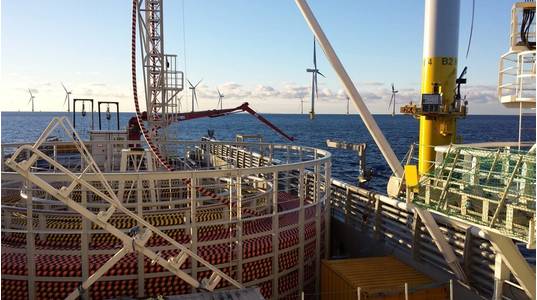
U.S. Customs and Border Protection clarified further the permissible foreign vessel scope of work for offshore wind cable installation in rulings issued on June 30, 2022, and September 2, 2022. In two instances – installation of cable protection and transportation of excess cable – CBP has narrowed permissive prior rulings.
CBP has long held that a foreign vessel may pick up pipe or cable in a U.S. port and lay it from that point to another point in the United States or otherwise between two U.S. “points.” What constitutes a U.S. “point” offshore is the subject of several CBP rulings. The rationale is that the laying of pipe or cable is not the “transportation” of “merchandise” between two U.S. points which is proscribed by U.S. coastwise law known as the “Jones Act.”
CBP has also long held that a foreign vessel can bury cable with a sled, tracked remotely operated vehicle, or other device, and it does not constitute “dredging” if the device utilizes water jets alone or in combination with a chain or disc cutter. “Dredging” in U.S. waters is reserved for qualified U.S.-flag vessels. “Dredging” generally means “excavation,” which in turn CBP defines to mean “hollow out” or “to remove soil by digging, scooping out or other means.”
Both the June 30 and September 2 rulings reaffirm these long-standing principles but add two new wrinkles. With respect to the installation of cable protection such as concrete mattresses or rock bags, CBP determined that a foreign vessel is not permitted to pick up such a device in a U.S. port and place it on already laid cable. The theory is that the already laid cable, regardless of distance from an offshore substation, shore, or an offshore tower, is itself a “point in the United States.”
Previously, CBP had indicated that cable or pipe laid on the seabed is not “attached,” which is a requirement to create a U.S. point beyond the 3 nautical mile limit.
With respect to excess cable, CBP had previously determined that a cable lay vessel could return to a U.S. port a de minimis amount of excess cable it had loaded at a different U.S. port. On September 2, CBP indicated that its 2019 guidance on what constitutes “vessel equipment” – which is an exception from the Jones Act – eliminated the de minimis excess cable determination. CBP reasoned that the 2019 guidance, which did away with prior de minimis reasoning in the context of vessel equipment, also did away with the excess cable ruling reasoning which was not based on the vessel equipment exception.
The article above was originally published on Winston & Strawn LLP's website HERE. Republished on Offshore Engineer with permission.
About the Author
Constantine (Charlie) Papavizas is a partner in the international law firm of Winston & Strawn LLP, resident in Washington, D.C., and is chair of the firm’s maritime practice group. Papavizas is listed in a number of legal guides, including Chambers USA, as a leading shipping lawyer. Mr. Papavizas represents ship owners, operators and managers, shipyards, energy companies, marine construction companies, financial institutions, and a variety of other interests in the worldwide maritime and energy industries. Mr. Papavizas has authored a number of articles on a variety of topics, including the Jones Act in “The Story of the Jones Act (Merchant Marine Act, 1920)” in the Summer 2020 and Winter 2021 issues of the Tulane Maritime Law Journal, as well as offshore wind in “Forming joint ventures to construct US offshore wind farms” in the March 2019 issue of Renewable Energy World; “Jones Act impacts on offshore wind” in the March 2019 issue Project Finance International; and “Does the Jones Act Apply to Offshore Alternative Energy Projects?” in the Summer 2010 issue of the Tulane Maritime Law Journal. Mr. Papavizas is also the co-author of the Practising Law Institute’s Maritime Law Answer Book and has been quoted in a number of publications on a variety of shipping topics.